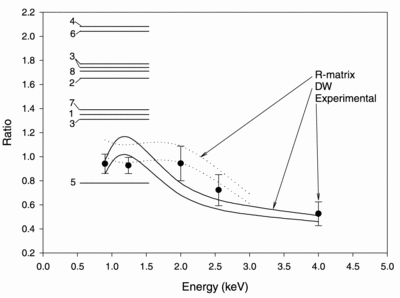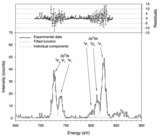Image Details

Caption: Fig. 3.
Variation of the intensity ratio ﹩\left(I_{16.780}+I_{17.055}+I_{17.100}\right)/ \left(I_{15.014}+I_{15.265}+I_{15.456}\right)﹩ with electron beam energy. The first three lines originate in the ﹩2p^{5}3s﹩ configuration and the second three in the ﹩2p^{5}3d﹩. For comparison, results from model calculations using the distorted wave results (see Bhatia & Doschek 1992) are shown, and where appropriate the R‐matrix results of Mohan et al. (1997) are overlaid. The range given for each calculation corresponds to the limits of unpolarized (upper curve) and completely polarized (lower curve) emission. The observational ratios from various solar and stellar observations are shown for reference on the same plot. For these, the energy scale on the x‐axis should be disregarded. Fe XVII is generally formed in plasmas at a temperature of ﹩5\times 10^{6}﹩ K, and electrons with energies close to threshold, i.e., less than 1 keV, dominate the excitation rate. The references are (1) Blake et al. (1965); (2) Parkinson (1975); (3) Hutcheon, Pye, & Evans (1976); (4) McKenzie et al. (1980); (5) Phillips et al. (1982); (6) Acton et al. (1985); (7) Brinkman et al. (2000); and (8) Canizares et al. (2000).
Copyright and Terms & Conditions
© 2000. The American Astronomical Society. All rights reserved. Printed in U.S.A.





